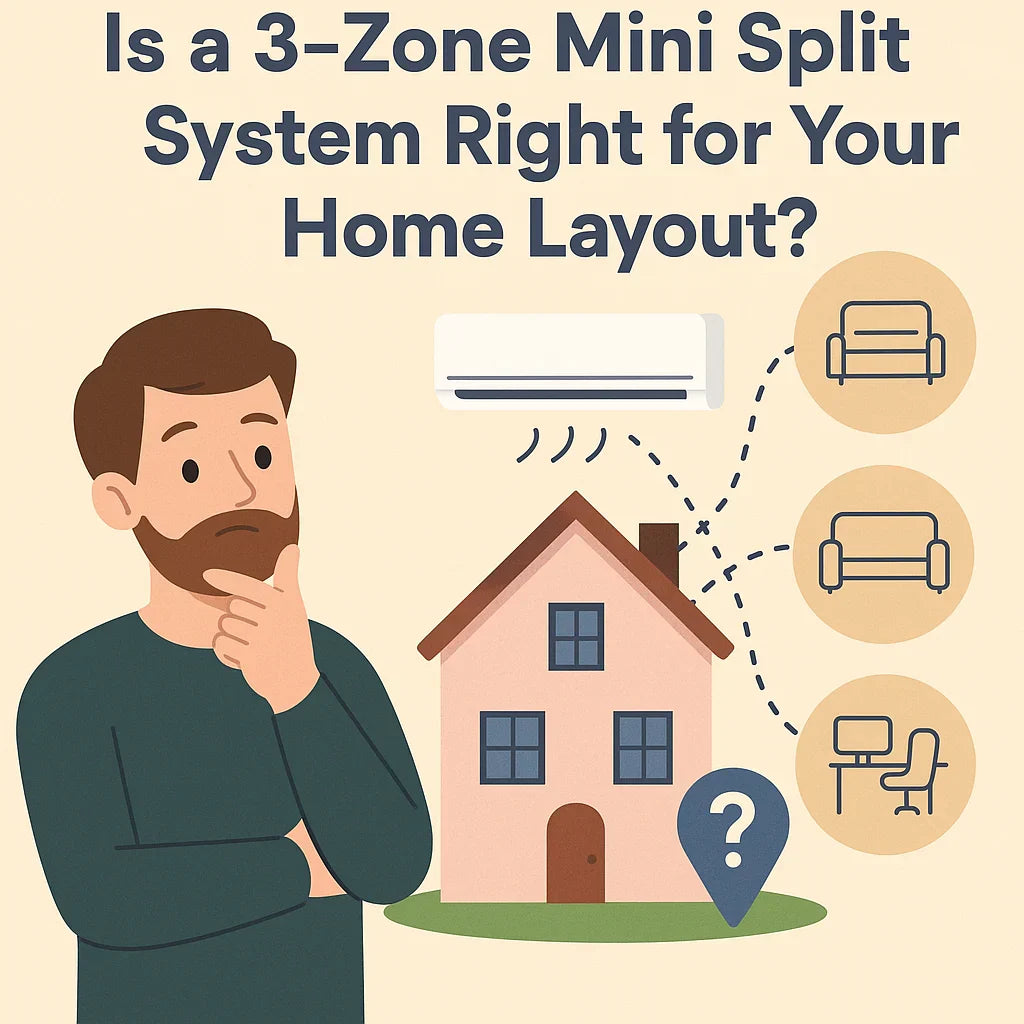If you're considering a 3‑zone ductless mini‑split system, you're about to unlock quieter comfort, lower energy costs, and room-by-room climate control. But is it the right fit for your house? Let’s break it down.
🔍 What Is a 3‑Zone Mini‑Split System?
A 3‑zone mini‑split system includes:
-
One outdoor condenser (the “mini‑split” outdoor unit).
-
Three individual indoor air-handling units (aka “heads”)—each installed in a different zone.
-
A network of refrigerant and control lines linking them.
Each zone operates independently, offering separate temperature settings per room without needing ductwork. That means no more fighting over the thermostat or pumping cooled air into unoccupied spaces.
(3-Zone Mini-Split Systems: A Guide)
🏠 Why Zoning Matters: Room-by-Room Comfort
1. Individual Thermal Preferences
You may prefer your bedroom cool for sleeping, but the kitchen or living area feels fine at a higher temperature. Zoning gives you that per-zone autonomy.
2. Closed-Off Rooms vs. Open Layouts
In open-concept homes, a single unit might work, but in closed-off spaces—bedrooms, home offices, bonus rooms—you often need dedicated heads. Three zones are perfect for handling a living room plus two bedrooms, or a combination of upstairs, downstairs, and a bonus room. How to Choose Best HVAC Systems
📏 When Does a 3‑Zone Setup Make Sense?
✅ Square Footage & Layout
-
Homes between 1,200–1,800 ft² with a few separate rooms often do well with 3 zones TechBullion.
-
Beyond 2,000 ft², you may need additional zones—but for many homes that size, 3 zones hit the sweet spot in comfort and cost-effectiveness.
✅ HVAC Load & Sizing
Each head's total BTUs must match the outdoor unit's capacity. A typical condenser might serve three units like 9k, 12k, and 18k, totaling 39k—but your home’s heat-loss/gain must align. Load calculations are key.
How to Choose the Best HVAC Systems
🌡️ Efficiency & Performance Benefits
💸 Lower Energy Bills
Since you're conditioning only the rooms you use, a 3‑zone setup trims energy usage. Zoning saves significantly versus running a full-home central system. The Furnace Outlet
📈 High SEER Ratings
Mini-splits often boast SEER2 ratings far above traditional systems—some single-zone models hitting SEER 30–40. Multi-zone still leads central systems by a wide margin. Home Inspection
🌍 Eco-Friendly
Using R-410A or even R-32 refrigerants, mini-splits have a lower environmental impact and contribute to reduced carbon emissions.
🛠️ Layout & Placement Strategy
📌 Where to Install Indoor Units
-
Living Room: High-wall mount is common and effective.
-
Bedrooms: High-wall works unless you have tall windows—then floor-mounted or ceiling cassette may be better. (Discover the Benefits of Three-Zone Mini-Split Systems)
-
Bonus Rooms: Use ceiling cassettes for attic conversions or concealed options for aesthetics.
📌 Refrigerant Line Runs
Plan minimal and efficient runs—bundle refrigerant and control lines to avoid heat loss.
📌 Outdoor Unit Placement
Keep it level, on a stable pad or bracket, with 12–24 inches of clearance around it. Position it centrally to all indoor heads to minimize line length and cost.
🔧 DIY vs. Professional: Installation Considerations
🔹 DIY-Friendly? (Kind-of)
-
Brands like MRCOOL offer “DIY” kits with pre-charged lines and modular controls—great for Jake the DIYer with strong mechanical skills. MRCOOL DIY Direct
-
Electrical work, per local code, may still require a licensed electrician.
🔹 Pro-Service?
-
Proper sizing, refrigerant handling (EPA-certified), and electrical compliance are best done by qualified HVAC techs.
-
Branch-box vs. multi-port outdoor units—complex setups are often simplified with professional advice and installation. (How to create a multi zoned mini-split system)
🧮 Total Cost Breakdown
| Component | Estimated Cost (USD, 2025) |
|---|---|
| 3‑Zone Outdoor Condenser | $2,500–$4,000 |
| Three Indoor Units (heads) | $500–$900 each |
| Installation & labor | $3,000–$7,000 |
| Additional materials (lines, brackets, disconnects) | $800–$1,500 |
| Total Estimated Cost | $7,300–$14,200 |
Factors include head type, ease of access, and whether DIY labor halves the install cost.
🎯 Ideal Use Cases for Jake
-
Living Room + 2 Bedrooms: Balanced airflow, independent control.
-
Basement, Office, Bonus Room: Target frequently used zones.
-
Upstairs vs. Downstairs Preferences: Keep floors individually comfortable.
-
Future Expansions: Many condensers support up to 5 zones—option to add more heads later.
⚠️ Potential Drawbacks
-
Upfront Investment: Higher than a single AC window unit or space heater.
-
Complexity: Sizing and installation are more involved than a single-zone setup.
-
Aesthetics: Indoor units are visible—ceiling cassettes and hidden duct options mitigate that.
✅ Final Verdict: Is It Right for You?
Use this quick checklist:
-
[ ] Do you have 1,200–1,800 ft² with multiple closed-off rooms?
-
[ ] Do you want per-room control and quieter operation?
-
[ ] Would you prefer to pay upfront for long-term energy savings?
-
[ ] Are you comfortable with a DIY install, or do you have a contractor lined up?
-
[ ] Can you tackle 20–40 ft line runs and minor electrical work?
If you answered "yes" to at least 3 of these, a 3‑zone mini‑split is likely an excellent fit for your home.
In the next topic we will know more about: Sizing Tips for 3-Zone Ductless Systems: BTUs Per Room Explained







